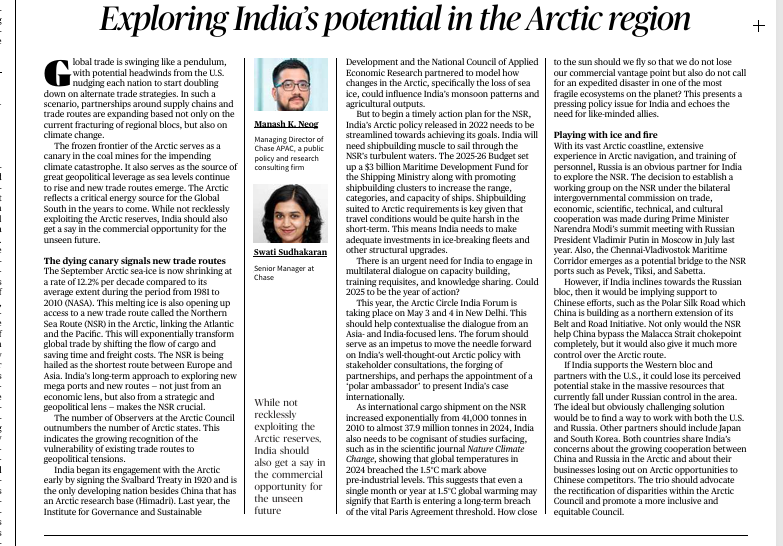Context and Significance
- Global trade shifts: The editorial starts by highlighting a shift in global trade due to geopolitical tensions and climate change. Traditional trade routes are becoming less viable, while new ones, like those through the Arctic, are emerging.
- Arctic’s strategic value: The Arctic serves as:
- A climate change indicator (“canary in the coal mine”),
- A potential commercial opportunity,
- A critical energy source,
- A source of geopolitical leverage for the Global South.
- A climate change indicator (“canary in the coal mine”),
2. Melting Ice & New Trade Routes
- September Arctic sea ice shrinking: Declining at 12% per decade (NASA).
- Opening of the Northern Sea Route (NSR):
- Links the Atlantic and Pacific Oceans.
- Reduces shipping time and costs between Europe and Asia.
- NSR is shorter and faster than traditional routes like the Suez Canal.
- Links the Atlantic and Pacific Oceans.
- India’s interest: As a rising trading power, India must strategically plan for tapping into the NSR opportunity.
3. India’s Current Challenges & Needs
- Need for clear Arctic policy:
- Though India has an Arctic policy (2022), a clear action plan is needed to realize it.
- Though India has an Arctic policy (2022), a clear action plan is needed to realize it.
- Shipping infrastructure gaps:
- India lacks ice-class ships suited for Arctic conditions.
- Investment is needed in:
- Ice-breaking fleets,
- Shipbuilding,
- Training, and
- Ice-breaking fleets,
- Budget support: ₹3 billion Maritime Development Fund under 2025-26 budget to support this.
- India lacks ice-class ships suited for Arctic conditions.
4. Policy & Strategic Recommendations
- Multilateral engagement: India must join dialogues on:
- Capacity building,
- Technology sharing,
- Multimodal logistics,
- Environmental regulation.
- Capacity building,
- India’s Arctic Dialogue Forum:
- Announced for May 2024.
- Will include both Arctic and non-Arctic nations.
- Platform for cooperation and policy alignment.
- Announced for May 2024.
5. Role of Russia & India’s Diplomacy
- Russia as a key partner:
- Controls NSR,
- Has invested in Arctic infrastructure,
- Is working with India on the Chennai-Vladivostok corridor.
- Controls NSR,
- India-Russia cooperation:
- Need to integrate Arctic vision with bilateral infrastructure projects.
- Explore trilateral/multilateral alliances involving other friendly countries.
- Need to integrate Arctic vision with bilateral infrastructure projects.
6. Geopolitical Challenges
- Chinese Arctic ambitions:
- China’s white paper (2018) labels it a “near-Arctic state”,
- Actively investing in polar science and shipping.
- China’s white paper (2018) labels it a “near-Arctic state”,
- India’s strategic balance:
- Must ensure it doesn’t fall behind in geopolitical contestation.
- Must ensure it doesn’t fall behind in geopolitical contestation.
7. Environmental Considerations
- Arctic exploration is risky due to:
- Fragile ecosystems,
- Global warming concerns.
- Fragile ecosystems,
- India must balance commercial interests with environmental sustainability.
8. Editorial Conclusion
- Balanced approach needed:
- Avoid overexploitation or commercial greed.
- Focus on long-term environmental and strategic gains.
- Avoid overexploitation or commercial greed.
India should be ready with policy coherence, alliances, and economic instruments to be a responsible Arctic stakeholder.
GS Paper II: International Relations / Governance
- Q1 (15 Marks):
“India’s engagement in the Arctic is as much a strategic imperative as it is an environmental responsibility.” Discuss India’s Arctic policy in light of shifting geopolitical dynamics and melting sea routes.


